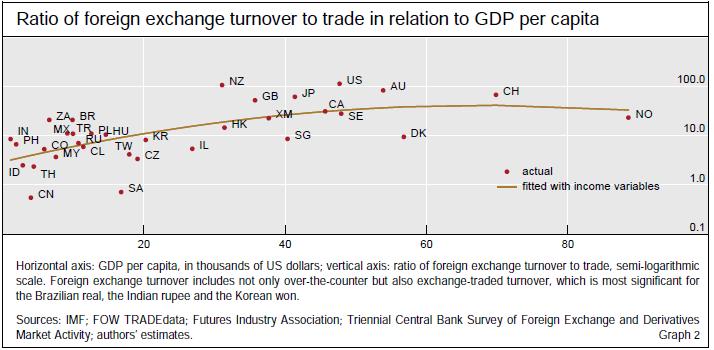April 9th 2011
Report Portends Changes to Forex Reserve Currencies
This week’s Bank of International Settlements (BIS) quarterly report came with some interesting revelations (most of which I’ll discuss in a later post). Below, I’d like to focus on one particularly interesting section entitled, “Foreign exchange trading in emerging currencies.” This section carries tremendous implications for the future of reserve currencies and is a must read for fundamental analysts.
According to the BIS, “Foreign exchange turnover evolves in a predictable fashion with increasing income. As income per capita rises, currency trading cuts loose from underlying current account transactions…moreover, currencies with either high or very low yields attract more trading, consistent with their role as target and funding currencies in carry trades.” In other words, the most liquid currencies (and hence, most suitable reserve currencies) are primarily those of advanced economies and secondarily those with abnormal interest rates.
In theory, one would expect a close correlation between forex turnover and trade. In fact, this turns out to be precisely the case for lesser-developed countries. Since the capital markets of such countries are commensurately undeveloped, offering limited opportunities for foreign investment, most of the demand for their currencies stems directly from trade. In fact, the currencies of Malaysia, Indonesia, Saudi Arabia, and (notably) China closely fit this profile, with a 1:1 ratio between forex turnover and trade.
At the same time, the BIS discovered a strong correlation between the ratio of foreign exchange turnover to trade and GDP per capita. That means that as a country grows economically and enters the realm of industrialized countries, its currency will experience exponential growth in turnover. For example, the British Pound and Japanese Yen are exchanged at a quantity that is 50 times greater than required for trading purposes. The ratio of forex turnover to trade for the US Dollar, meanwhile, exceeds 100!
The BIS was able to fit a regression line to the data that seemed to explain this phenomenon quite well. The majority of economies/currencies that it surveyed fall pretty close to this line, suggesting that forex turnover is exactly where it should be relative to GDP per capita and trade. In fact, the line runs directly through the Euro, Hong Kong Dollar, Canadian Dollar, and Swedish Krona, and Norwegian Krona.
There are also plenty of outliers. Given the size of China’s economy, for instance, the model would predict that turnover in the Chinese Yuan should be 2-3 times what it currently is. Unsurprisingly, all of the world’s major reserve currencies (except for the Euro) can be found well on the other side of the regression line. Turnover in the US Dollar, Japanese Yen, and Australian Dollar is almost twice as high as the model predicts. Perhaps the most flagrant outlier is the New Zealand Dollar, which seems to be traded at a frequency that is 8-10x higher than it should be. Of course, New Zealand is a unique case; there isn’t another economy that is as small and stable, and yet always has higher-than-average interest rates.
One interpretation of this analysis is that demand for the all of the currencies that fall above the regression line should decline over time, and should experience at least some depreciation. The opposite can be said for currencies that currently fall the regression line, especially if their economies continue to expand at a faster-than average pace.
At the same time, it puts things into perspective. Even if demand for the Chinese Yuan doubled in accordance with the BIS model (which would necessitate looser capital controls, among other things), GDP per capital would need to increase 20x and US GDP per capita would need to remain constant in order for the Yuan to rival the Dollar in importance. Also, I’m beginning to wonder if the New Zealand Dollar isn’t in fact oversubscribed and overvalued…





April 14th, 2011 at 4:49 am
Most currencies that seem to fall below the regression line are under currency control regime which hampers liquidity in some cases and shies away investors.